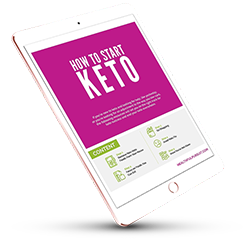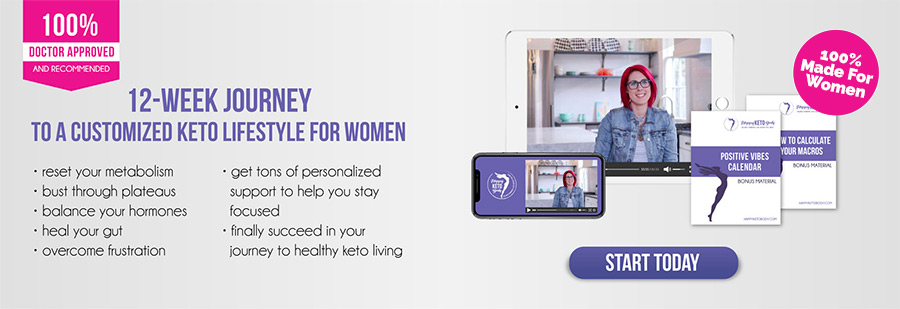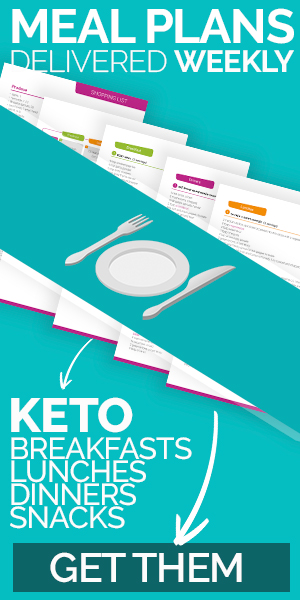I want...
Video: Eating Low-Carb, Keto and Thyroid Imbalances
September 16, 2015 By
Leanne Vogel

 October 5, 2018
October 5, 2018

Everything thyroid – how it’s affected by a ketogenic (high-fat, low-carb) eating style, how sex hormones and stress influences the thyroid, what synthetic hormones do to your thyroid, and more.
You asked and we’re delivering in this riveting interview with Vivica Menegaz, certified nutritionist and creator of the Healing Foods Method. We made talking “thyroid” as invigorating as possible in this 50-minute interview with dozens of metaphors, analogies and laughter.
Keto shopping lists, recipes, and more! Start keto with this FREE 5-step guide.
I'm ready!A must-watch if you have been diagnosed with hypothyroid, experience hypothyroid symptoms or you are a woman who’s interested in going keto.
For video transcription, scroll down.

Highlights
- How sex hormones and cortisol irregularities affect your thyroid
- The reason behind stubborn weight gain
- Steps to support your thyroid with a ketogenic (high-fat) eating style
- The components that wreak havoc on your thyroid
- How the classic ketogenic diet may not be your best option for thyroid health (and what to do instead)
- The benefits of a therapeutic ketogenic diet on thyroid
- What synthetic hormones do to your thyroid
Resources
- Visit Vivica at Nourished Caveman
- Lab testing for several biomarkers from True Health Labs
- Therapeutic Keto plan with The Keto Beginning
- Subscribe to my YouTube Channel
Video Transcription
Leanne: Hi, everyone. Today, we are joined by Vivica. I’m going to introduce her in a second, but she is here to talk to us all about thyroid. I get so many questions about thyroid imbalances, on low-carb, eating high fat, on high carbs, so we want to break it all down for you today and give you information about your thyroid for women. There’s a lot of information out there, but it’s not specific to women, and we are both women who know a little bit about thyroid, so let’s get right into it.
Vivica is a certified technician in whole nutrition with four years of clinical practice. Originally from Italy, she grew up in a family of restaurateurs, learned to cook from professional chefs, and soon discovered her passion for food. After moving to the US, Vivica had a successful career as a food photographer, and then decided to study nutrition, her true vocation. Vivica now lives in the foothills of the Sierra Nevada with her husband and many spoiled pets, and there are a lot of pets.
Last year, she opened her own web-based practice specializing in therapeutic ketogenic diets. Vivica is also the creator of The Healing Foods Method, a 10-week course to transform health and lifestyle with a focus on metabolism and endocrine rebalancing. Vivica’s blog, The Nourished Caveman, is filled with delicious keto, paleo recipes with lots of useful information. Thanks for coming on the show.
Vivica: Thanks for having me. It’s so exciting. It’s awesome.
Leanne: Yeah. We’re matching a little bit, like we’re channeling the white.
Vivica: I know.
Leanne: Okay. I did a little bit of introduction and I want to just jump right into it, unless you want to say something before, because we have a lot of questions.
Vivica: No. Let’s go ahead. Let’s do it.
Leanne: Okay. I paneled the Healthful Pursuit readers in our community and they had a bunch of questions. I thought we’d do like a good introduction to the thyroid gland overall. Can you tell us a little bit about what the thyroid is for people that don’t know?
Vivica: Okay. The thyroid, it’s located right here, first of all. You can actually feel your own thyroid when you swallow. If you go like this, you’ll feel a little movement inside.
Leanne: Dude.
Vivica: Like, “Wa-wa.” It goes up and down. That’s a really good thing to locate your thyroid, know where it is, get familiar with it. We call it the master gland because the thyroid is really the main gland of the endocrine system. It’s a regulator. Thyroid hormones have effect on a lot of different bodily functions.
If you look, there is a thing called the Harrower’s chart which is from Dr. Harrower. It’s a chart of endocrine connections. It shows you all the interdependence of the endocrine system. It shows you all the connections between all the different glands and how the suppressors stimulate each other. The thyroid is one of the ones that you really see. It has the most connections and really is tied in in the center of the endocrine system.
Sometimes … I don’t know. I was talking to a patient with this metaphor yesterday. It was really funny. Nutrition is your journey. You start to climb Mt. Everest. Then you’re going up this mountain and you’re working on all the different things on the pillars of nutrition. Digestion, detoxing, blah, blah, blah. Then you reach the top of the mountain, and then sits a golden temple in the shape of a thyroid.
Leanne: Oh my gosh, that is perfect. Yes.
Vivica: Which is good visual, too, like give you the importance of the thyroid in the body.
Leanne: Yes. It’s so true. So many issues stem from the thyroid imbalance.
Vivica: Yes. Although the thyroid sits on top, that means that it really … I’m jumping ahead here a bit, but one of the main issues that we face nowadays is trying to fix the thyroid without fixing everything else it rests upon. The thyroid is really the pinnacle and the controller, but in order for you to function properly, we need to address all the other underlying factors that determine thyroid health.
Leanne: You’re saying that hypothetically, if somebody has a low thyroid, chances are, if their thyroid is low, there’s a lot of other things going on and you need to fix all those other things before or during the time that you’re fixing your thyroid. Would that be fair to say?
Vivica: Yes. Most definitely.
Leanne: What hormone specifically is the thyroid related to? You hear a lot about the thyroid can impact the adrenals which produces cortisol. How is that connection put together?
Vivica: The thyroid itself produces … The main hormones are T4 that then gets converted into T3. Then, also, it’s about 90% T4 production and 10% T3. T3 is the active form of T4. It’s quite complex. Actually, the workings of the thyroid, they are quite complex. I’m still always putting it all together. It’s a really complicated puzzle, but that’s our physiology in the end.
It also produces … There is reverse T3 and then T2. Calcitonin is also produced that affects calcium levels. I hope I’m not saying something wrong here. If you want to look at the relationship with the adrenals and the thyroid, sometimes we call them two hands of the same stick. It’s like you have adrenals and thyroid, and you cannot really move the stick without sending one out of balance. There is this really strong connection.
I like another analogy even better, which is the pyramid. You have adrenals on one corner, and ovaries or gonads on the other corner, and then the thyroid sits on top. In order to achieve the balance, everything has to be stable and solid. Also, it’s a great analogy for a practitioner because it really explains you how you need to start addressing adrenal and sex hormones before you can work with the thyroid directly. You can support the thyroid, but without doing the other work before, it’s really useless.
Leanne: I always say in my practice with that triangle that you said, it’s like a three-legged stool, and when you kick one leg out, it just falls over.
Vivica: That’s a great.
Leanne: You can’t make it work. That’s another analogy for your practice.
Vivica: I like that. “Whoops!”
Leanne: Yeah. “Whoop!” That’s often what happens. What are the symptoms of thyroid imbalance? How would somebody know, if somebody is watching this … I’m thinking a woman is watching this and thinking, “Okay, so I know what the thyroid is, but how do I know if it’s imbalanced?”
Vivica: Well, specially for women, and I would say in my case, very closely related to myself, for women over 40 which are the most likely to start developing thyroid problems, one of the main thing you notice is the weight gain. It starts with really noticing that you’ve gained a bunch of weight and you can lose it no matter what you’re doing.
Of course, there is also a metabolic pathway involved in that. I’m big on ketogenic diet because a lot of people have carbohydrate intolerance, and that is involved in that weight gain, but, again, if you go around to the other side, it is related to the thyroid through the carb intolerance as well.
When you’re carb intolerant, then you stress your adrenals because your cortisol has to regulate your sugar levels all the time. You’re constantly putting the stress in the adrenals. Your blood sugar is going up and down like crazy like a roller coaster. That stresses the adrenals, and when the adrenals are stressed, the thyroids start toppling over that stool.
Again, the weight loss is connected in both ways, metabolic pathway, and then directly to hypothyroidism. Then there are things like depression. That’s another really big one. When you’re the blues, the constant blues, not being able to get one, that’s easily solved with some Prozac. Depression is a Prozac deficiency.
Leanne: Yeah.
Vivica: Anyways. Another symptom is cold hands and feet, especially hands and feet, but just this general feeling of being cold and not being able to warm up. Having like [00:09:06] you like to sit in the sun like a lizard. You’re never sweating. By the way, one little tidbit of information that I learned not recently, when you know certain people don’t sweat …
Leanne: Yes.
Vivica: They’re like, “Why I don’t sweat? I can’t sweat.” Well, guess what? That’s a iodine deficiency.
Leanne: That’s really interesting that you say that because I started supplementing with iodine about four months ago, like in May, and I was like I sweat, but never crazily. I’d go to hot yoga and maybe I’d get a couple of drips. The last couple of weeks, I am drenched in sweat. Drenched. I was like, “What is going on?” In yoga, in my sauna. Okay.
Vivica: That’s fantastic.
Leanne: Interesting. Interesting.
Vivica: Yup. Thank you for reconfirming that.
Leanne: That is so cool. I couldn’t put the two together, so thank you for confirming it for me. What are the causes of a thyroid imbalance? In know that I’ve heard, especially here in Canada, in our city, we actually got our fluoride taken away from our water. Thank goodness.
Vivica: Oh really? They did?
Leanne: Yeah. They took it out, but I’ve also heard that chloride and bromide, these are the three that affect our thyroid. Are there other things? How did those items take …
Vivica: Halogens.
Leanne: Sorry?
Vivica: Yeah. Halogens.
Leanne: Okay.
Vivica: Halogens are directly related to iodine deficiency because what happens when you’re deficient in iodine … The thyroid really needs iodine. Iodine and iodide. It’s basically iodine, in both forms of iodine and iodide, goes into the thyroid and is basically one of the pieces of the T3 and T4 hormones. Without iodine and iodide, T3 and T4 are not created in the thyroid.
We are all really iodine deficient. Especially if you don’t live by the ocean, you’re not eating fish everyday, you don’t eat seaweed, you live inland, your soil is iodine deficient. In America, there is one thing called the goiter belt. It’s this area where everybody has goiter, and that’s because the soil is iodine deficient and it’s inland. By the thyroid being iodine deficient, then it is prone to absorb other halogens just because it’s like, “I really need this, but it’s not available! Okay, this looks almost similar. Let’s put it in.”
Leanne: Interesting.
Vivica: Molecularly, all the halogens are very similar. I think there are just one atomic composition difference, very, very slight difference, but the iodine is the healthy halogen while the chlorine or fluorine, fluoride … Chloride is actually not as bad. For some reason, it seems to be present in nature. It’s not as toxic, but bromide and bromine and fluoride and fluorine and chlorine, those are all really, really toxic.
Leanne: As a girl who has a hot tub, because she thought it was a good idea when she was a runner, I never go in that thing anymore, but for people that are swimmers or going to the hot tub, you would think that … I take a lot of my medicine and supplements on my skin, so by sitting in a hot tub with all that stuff, that is what you’re … You’re soaking up those things into your skin and into your body. Just a heads up.
Vivica: Yup. Absolutely. The good news is that there is a way to prevent this from happening, and that is doing iodine loading. Saturating your body with the iodine it needs, and then once your body is iodine-saturated, you don’t absorb. You don’t need the halogens anymore, so they’ll just bounce off of you pretty much.
Leanne: Is the test with the two inches of iodine on your skin to see whether or not it soaks in, is that a good test? I’ve read that, but I don’t know.
Vivica: No. Unfortunately, what happens is the test is very unreliable because about 60% of the iodine evaporates within the first minute, depending on room temperature. If the room is over, I don’t know, 70 degrees, then most of the iodine just evaporates. You would have to have very clinically controlled environment in order for this to be a reliable test, and that doesn’t happen.
What is really good for iodine test, there are two kind of iodine tests. One is the 24-hour iodine loading test, and it’s done with multiple samples of urine. Then the other one is just a one-sample urine loading test that you do. You got [00:14:02] iodine at night, and then you pee in the morning, and they sample it. The other one, they just load you up with, I don’t know, 150 milligrams. Depending on the lab, it’s different. Then they test you within 24 hours. You have to collect urine samples within 24 hours, then put them all together and send them in.
Leanne: Since we’re on the iodine topic, something related to this, I guess to summarize what you’ve said so far is that iodine is the super nutrient for our thyroid. I think that’s fair to say. I started taking iodine, like I said, but over the last, I would say, week, I’ve been getting lower gut pains every time I eat them or have my iodine drops. Do you know why that could be, or if you’ve heard of something like that before? Not to put you on the spot. I was just curious.
Vivica: No. Yeah. The first thing that comes to my mind, it can be a detoxing reaction. When you start taking iodine … Iodine is a whole other topic. That’s a huge topic. There is lots of controversy about it, but I love this topic. I’m happy to talk about it. You can start detoxing from halogens at any time.
To really load your body with iodine, it takes about a year to three years. It’s not a quick process. This is doses of like 15 to 50 milligrams, not microgram, milligrams per day, which is also something that for people with Hashimoto’s would not be recommended. I would do it in a very different way.
Let’s say you don’t have Hashimoto’s and you just have thyroid issues, primary hypothyroidism, and you want to do iodine loading. Keep in mind, if you don’t do it with a practitioner, that at any point in time, you can start getting into a pocket of toxicity as your glands and your tissues saturate. Your iodine is stored in the thyroid, it’s stored in the breast tissue mostly, and it’s stored in the skin, too, at some level. A bit less. For example, there has been cases of people that after three, four months started oozing bright yellow stuff out of their breasts.
Leanne: I’d freak out.
Vivica: That’s fluoride, fluorine coming out from the breast tissue. In fact, that’s one of the reasons why iodine is one of the most amazing cancer preventative because you will keep that breast tissue saturated and healthy so that nothing bad will go in there. Also, it’s really protective for the cells. It enables the cells to work at the best efficiency level, so that is great prevention.
Leanne: Okay. What you’re saying is put some more iodine in my water tomorrow and just … Yeah, it was just weird. Lower gut pain, and I’m like, “What is going on?”
Vivica: I wouldn’t add more.
Leanne: No, I stopped taking it a couple of days ago because I was like, “This is brutal, so get back to doing that.”
Vivica: Maybe pull your dose in half.
Leanne: Okay. Good to know.
Vivica: Whenever that happens, I would go back to those and just take it easy, but go steady because you need to come through that detox part …
Leanne: Interesting.
Vivica: … So that you can clean up and load and then keep going.
Leanne: I had no idea. Okay, that makes sense. Now getting to low carb diets and ketogenic, because we’re both keto girls, are there risks to doing a ketogenic eating style and your thyroid? You hear a lot about ketogenic eating styles maybe not being so good for the thyroid, or eating low carb, keto not being good for the thyroid. Can you talk a little bit about your experience with that?
Vivica: Yeah. First of all, I really don’t think it is true, but then again, we need to do a bunch of consideration about that statement. I don’t work with just random ketogenic diets. I work with the therapeutic ketogenic diets. That means that I work with elimination diet as well. My ketogenic diet is paleo mostly. I would say 90% paleo.
I check and test for allergens and sensitivities. That connects me back to the staples, the pillars that support the thyroid, because one of those pillars is gut health and digestion. For example, if you have sensitivities that … Dairy, for example. Pork. Eggs. It could be anything. Grains, not really because we don’t do that on keto, so it is one last thing to worry about.
Leanne: Yeah. True.
Vivica: When you have a leaky gut and you have that dairy protein leaking in, it starts a whole chain reaction. You will not be able to absorb the right nutrients that the thyroid needs when your gut is not functioning, and your upper digestion also, not enough HCl, so the whole digestive system and the balance of digestion is really related to thyroid health. It’s one of the basis. If you’re not doing a therapeutic diet, just a random ketogenic diet where you say, “Okay, I’m going to McDonald’s but I’m eating keto mackerels” … which is possible.
Leanne: Totally.
Vivica: Some people do it.
Leanne: Yes. I have met those people.
Vivica: Right. That, it wouldn’t be good for the thyroid for sure, but as far as just if we just talked about a clean therapeutic ketogenic diet and the carb restriction, I have to say that women have different carb needs than men, and especially women of a certain age. When you’re 20, it’s very different than when you’re 40 or 50 or 60. For women, I feel that what works the best … Remember, we talked about it in our first chats, private [00:19:53] chats before …
Leanne: Yeah, we did.
Vivica: … About ideal carb levels. I find more and more that what I do, I use a very low level of carbs for keto adaption, like 20 grams, but once we are properly keto-adapted, then I tend to raise them depending on the situation and the metabolism. If you’re a woman, and let’s say a woman over 30, unless your problem is strictly metabolic, and let’s say you have diabetes but your adrenals are fine, your thyroid is fine, endocrine system seems to work fine, it’s possible. Not common, but possible.
Leanne: I’ve never met with anyone who has that profile. One?
Vivica: Yes.
Leanne: Wow. That’s amazing.
Vivica: She’s Canadian, by the way.
Leanne: Yes. Yup. Represent.
Vivica: Unless it’s that very rare and specific situation where I would say, “Okay, pancreas is our main focus, carb intolerance, super high, insulin resistance, super high,” then we need to keep the carbs really low and controlled, but otherwise, I think that it is healthier to try to bring up the carbs to the sensitivity level, so where we can do the highest level of carbs for your tolerance. It might be 50 grams a day, it might be 60, it might be 90 for some people.
You can reset a lot of your insulin resistance by doing strictly low carb, keto, and there are a lot of techniques for that specifically, but once you’re now so insulin-resistant and you start to be insulin-sensitive, then you can have more carbs. Of course, good carbs. Lately, I’ve been prescribing my patients my new recipe for keto bagels, and they’re just super fiber. They’re called the “Colon Cleanser”.
Leanne: Yeah. Get things moving.
Vivica: Super high fiber. They’re very high fiber, and mostly higher carbs are what irregular keto food would be, but they are really good carb. When you’re in ketos, you need that fiber desperately, so it seems like one of the little tricks that I use to raise carbs without having them fall into things like potatoes or rice. Don’t do rice.
Leanne: Even white rice? You would say, “Don’t do white rice”?
Vivica: I prefer not.
Leanne: Okay. Yeah.
Vivica: It might just be a personal stigma, but white rice doesn’t have a lot of nutrition.
Leanne: No, I totally agree. The only reason I don’t eat rice is because I can’t stop eating rice. It’s like an empty … It makes me want more rice and rice and rice.
Vivica: It’s sugar.
Leanne: I have some clients that they enjoy having white rice, but it’s like, yeah, at the end of the day, you’re not really filling up your plate. There’s not a lot of nutrients there.
Vivica: Yeah. That’s why for fiber … Not fiber, but carb and fiber together, which is fiber is part of the carbs, but I like to use things more like seeds that are nutritious. Usually, they’re quite neutral in a way, so they seem … Although, in my patient, I see over and over that not everybody is sensitive to the same things.
Some people will do great with psyllium [00:23:19] or will do great with chia, and they will do horrible with flaxseeds, and some peopl, it’s the opposite. It’s really like you see over and over that you can’t make a general statement when it comes to diet and what works for your body individually. You have to really play in and see what works for you.
Leanne: Totally. I love that you mentioned that carb depletion and then increasing carbs. In fact, with my new book, Fat Fueled, I have three different profiles that I’ve done for people, saying, “Do this,” but then, yeah, find that tolerance and go as high as you can go because you will become more sensitive, and then it makes it a lot easier.
Vivica: Yes.
Leanne: I would fall asleep at anything over 80 grams of carbs. I would eat carbs and then just pass out. Now, I can do 80 grams of carbs, no problem, and it’s no big deal, so it’s amazing to see how your body changes with time. Is it fair to say that there are some hormones that the thyroid is responsible that need carbohydrates in order to convert?
Vivica: I’m not sure. Honestly, for the kind of endocrinology that I do, which is functional endocrinology, I have never seen a direct correlation between …
Leanne: Okay. Okay.
Vivica: It’s not talked about. I don’t know. I know there is a lot of talk of that out there and also in functional medicine, but with the kind of nutrition I do, it’s a little bit different because it’s … I don’t know what you would even call it. It’s like foundational nutrition. We only use whole food supplements. I don’t use the isolates like the functional medicine doctors do.
We’re a little bit on two different steps. Sometimes there are … For example, the iodine, that’s a big discrepancy because functional medicine doctors tell you, “No iodine at all for Hashimoto’s,” and I use iodine for Hashimoto’s. I use it very, very carefully and in small dosages, but, yes, I do. Same with the carbs. It’s different opinions on different things.
Leanne: It’s so true. At the end of the day, you just have to try some things, and if you don’t feel good, then you know that that’s not working, and how do you shift that. That’s why we’re both here, that’s why we do what we do, because sometimes when you’re in the heat of it, it’s hard to determine what you need to do personally.
To have a coach or something, being like, “Okay, well, have you tried this and that? I saw this with this other client. Have you tried this,” it brings a lot more into perspective. I know, even for myself, I have a coach because sometimes I’m just like, “I don’t even know what is making me do this,” because you’re right in the heat of it.
Vivica: Absolutely.
Leanne: For people that are listening, women especially that are listening, that know that they have a thyroid condition, maybe they have hypothyroid or Hashimoto’s, if they wanted to try a ketogenic, and our approach, which I believe that my approach, too, is very therapeutic like yours, if we wanted to go toward a ketogenic eating style, like you mentioned before, I guess it’s just like, “Do the therapeutic kind if you know that you have a thyroid imbalance or any imbalance with your health.” Do more of a therapeutic form of ketogenic eating as opposed to the sausages with the eggs, and conventional eggs with the cheese and the sour cream on your place [00:26:37].
Vivica: Exactly. Right.
Leanne: Yeah. Is that fair?
Vivica: I’m so glad that you share my same point of view.
Leanne: Yeah. Otherwise, I don’t think … I love having people on the show to talk about health and stuff, and I love when we don’t agree with things, but I also want to make sure that I’m responsible for sharing this information with people. I want to make sure my guests aren’t saying, “Yeah, totally, it’s fine to have conventional meat,” because I don’t think that that’s responsible of me to have a guest on there that just I can’t agree with the recommendations that they’re giving.
Vivica: I know.
Leanne: Yeah, I’m happy that we agree on that. In your introduction, we mentioned that you focus on rebalancing endocrine systems. What are five steps that listeners or watchers could do right now to balance out their thyroid? Maybe they’re interested in ketogenic eating style. Maybe they’re already doing it. Are there a couple of steps that you would recommend doing?
Vivica: Yeah. It’s the steps that I use in my practice to achieve that. I’ve got to tell you, it’s not always easy to do it by yourself, but if you’re up for it, go for it. You can always try.
Leanne: Then if you fail, call us.
Vivica: Exactly. We’re still here, right?
Leanne: Yeah.
Vivica: Leanne [00:27:51] and Vivica will help you.
Leanne: Yeah.
Vivica: I would definitely start from cleaning up your act. Cleaning up your diet, eliminating possible food sensitivities. Going dairy-free sometimes really helps. Eggs and pork I eliminate when I do a detox phase, but you really could try to be as clean as possible, definitely eliminating toxins.
I always do a detox on my patients when they start my program. Even if they don’t do the program, I do individual consults, I try to make them do a detox because it’s the basis for nutrition. Cleaning out, avoiding allergens, and supporting your liver, that’s all one step for me.
Then step two would be digestion, of course, and making sure that your digestion is working. Upper digestion, maybe HCl supplements that can help you break down that protein. That is what it was going through. It will digest for you. It’s not ideal. There is other things that are better when you get into really fine-tuning digestion, but at least that will do the job so that you don’t get partially digested protein through you digestive system, which is really bad.
Then, of course, lower digestion, probiotics, and eating a good … Fermented foods are great. Cultivate the microbiota. Digestion is second. Adrenal health is third. We know how important that is.
Leanne: Yeah. My smile curled up when you said that. Yes.
Vivica: those adrenals.
Leanne: Yeah, yeah.
Vivica: It’s like the woe of our generation or our time because we’re all way too stressed and we’re too busy and way too many demands on our time and on ourselves. Adrenals, meaning stress management and adrenal support. Yes, people, adrenal fatigue does exist. Come on. Get real.
Leanne: Right? How could you not think that it doesn’t?
Vivica: Because conventional endocrinology, I’m sorry I’m going to say this, forgive me all out there, but it’s in the middle ages. It’s in the dark ages. Really, conventional endocrinology is like has a blinder on. Anyways. That’s adrenal support. Then I would do definitely gonads, meaning sex hormone support. Make sure that your sex hormones are balanced. That’s a very other tricky …
See? That’s what I tell you. Working with the thyroid, it’s not easy. It’s a complicated picture. You really do have to address all these pieces of the puzzle. That is one, and again, I do just … It’s called restorative endocrinology or functional endocrinology, but I just work with rebalancing naturally the hormones.
I don’t use bioidenticals, not even the safest drop sublinguals. I don’t use any of that. I try to do it naturally, but I use herbal supplements and whole food supplements. If that is hard to do by yourself, unless you really know what you’re doing, I would suggest working with a practitioner.
Saliva tests are great for that. Also, saliva test is great for the adrenals. There is one called the adrenal stress index. The ASI test. That’s a great one to see your cortisol pattern so you can have a better idea. By the way, there are websites in the United States where you can order those tests yourself.
Leanne: That’s amazing.
Vivica: You might not know how to read it, but you don’t even need to go and beg your doctors. Doctors are being such pains.
Leanne: So many of my clients are just … I give them a list of blood work to get and their doctor is like, “No, you don’t need this.”
Vivica: Right?
Leanne: It’s obvious that they have a thyroid issue. We just want to know where’s our thyroid at, what is our cortisol level, what are their adrenals doing, what are their sex hormones … The stool, just to see, the three-legged stool, what’s going on. They’re like, “No, you don’t need that,” and it’s like, “Are you kidding me?”
Vivica: No. Then you bang your head against the wall.
Leanne: Yeah. It’s unfortunate because then a lot of people will say, “Oh, well, my doctor said that it’s not a problem.” Well, find a new doctor, really. Just, it’s your body, it’s your health, and at the end of the day, they’re not responsible, really, for how you feel. You are. If you don’t feel good, you got to do something about it. It’s awesome that they have those tests in the US.
Vivica: Yeah.
Leanne: Now it just needs to come up north to Canada.
Vivica: I think you can order them for Canada.
Leanne: Really? Okay, I’ll have to …
Vivica: I can send you a link for a site that you can just order tests privately. They have international locations. I know they have in Europe, so maybe also for Canada. I’ll send you a link.
Leanne: Cool. I will add that to the show notes below so that everyone can check it out if it’s something that resonates with them. I chatted with my community and I have a bunch of rapid-fire questions for both of us. If you can’t answer, I’ll answer it. If I can’t answer, you answer.
Vivica: Wait, we forgot, real quick, the last thing. The fifth step.
Leanne: Oh my gosh! I thought you did five. Do it.
Vivica: That’s fast, but thyroid support. Duh.
Leanne: Yeah, of course.
Vivica: The nutrients that the thyroid need which are vitamin C, vitamin D, iron, and, of course, iodine. All the good stuff that the thyroid need to function, and protein, because without thyroglobulin, nothing gets made. If you can’t break down that protein in your stomach and your thyroid doesn’t get the protein to make the hormones, then you don’t have the raw materials.
Leanne: That goes back up to digestive health because if you don’t have the hydrochloric acid, you’re not breaking down the protein, and it’s like a whole mesh.
Vivica: Exactly. Yup.
Leanne: Like untangling spaghetti.
Vivica: Yeah. White spaghetti.
Leanne: Yeah. Take one piece at a time. Okay, yeah. Thanks for the five steps. Geez. Okay, rapid-fire questions.
Vivica: Let’s go.
Leanne: If you have a history of thyroid imbalance in your family, how do you best support your thyroid? Are there changes to steps above that you just mentioned, or do these steps change when you have an autoimmune condition of the thyroid?
Vivica: With autoimmune, it’s a little bit of a different ballgame because you have to consider and factor in the autoimmune component first. You do support your body in general. You have to still do all the work that we talked about, but you have to work with also immune regulation. I’m not saying immune suppression here because that is just middle ages. I’m sorry. It’s called immune regulation. Just to make sure you support and regulate your immune system.
For example, there is a lot of controversy, again, about Echinacea. There is this big talk about functional doctors say, “Oh, it’s a Th1 pathway dominant or a Th2 pathway dominant, and if you’re Th2 pathway dominant, Echinacea is bad for you,” but, no, it’s not true because from herbalists, in thousands of years of use of this herb, we know that, and I’m not an herbalist but I use it, Echinacea is an immune regulator. That means it does support whichever part the immune system needs, and that includes both pathways. Just a tidbit [there [00:35:28]. When you work with Hashimoto’s, you have to seriously consider a bunch of other issues.
I would say, if it’s in your family … Another big talk these days is genetics. Everybody wants to have all these fancy genetic tests done, and then they’re like, “Oh my goodness, I have this gene! Let’s have my boobs cut off!” That is pretty insane to me because, you guys, remember, there is such a thing called gene expression. That comes from epigenetics, which is a great new branch of studying that I love. I recommend everybody to get into epigenetics.
It has a lot of answers, but one of the main thing that epigenetics tells us is that genes do not necessarily express. For example, in the case of thyroid or related to iodine, in the family, you might have bad genetics when it comes to predisposition, but that does not necessarily mean you are going to get the same issues as your mother or your grandmother because you can just use nutrition to modulate.
Again, figure your body and with proper nutrition just make [00:36:44] so that the DNA never needs to express certain genes versus others. One word: You’re healthy. You’re not getting sick because you’re healthy, you’re well-nourished, you’re balanced, you’re eating well, you’re keeping everything in check. As far as genetics, it’s nutrition prevention. Nutrition is prevention.
Leanne: Totally. Amazing. The next question is, is it possible to go too low carb, ketofor too long? What effect does that have on our thyroid and our adrenals and our sex hormones? We touched on this, but I want to drive that home so I added that question again from another reader.
Vivica: I just think that in general, for women metabolic systems and endocrine systems, that going very, very low carb for a long time is just not appropriate for our body. Honestly, what is the exact physiological pathways of expression of that, maybe I cannot tell you, but I’ve seen it and I’ve experienced it.
I just learned it from clinical practice. Seeing how you were really … It’s so much better to find your individual tolerance level and work with that instead of just ballpark like, “20 grams. Everybody, stay under 20 grams.” That doesn’t work. For men, men have a very much simpler hormonal profile.
Leanne: Yeah. I’m just sighing because my husband, it’s so simple for him.
Vivica: Men are, in general, something [00:38:22] … I don’t know. How did that happen?
Leanne: I love being a woman and I wouldn’t trade it for the world, so, just saying that [00:38:30].
Vivica: I know, but everything is a lot simpler for a man.
Leanne: Yeah.
Vivica: For our hormonal picture, I really think that it’s much more delicate and individual. I really think that it’s better for us to work on individual basis. That said, no, I don’t think it’s a good idea to go low carb for too low and too long.
Leanne: Amen. Thyroid medications. There’s a bunch of questions on thyroid medications from my community. What are the types of options? If you are a low thyroid and it’s quite low and your doctor says you need to go on thyroid medication, what are the types of options, and what’s the best and worst option?
Vivica: Okay. I will say in general that thyroid medication has a place. That place is where the patient is so symptomatic that you can’t function. It does bring relief and it’s something that it can be used for a short period of time to really bring up the symptoms and start feeding the thyroid or supplying the hormones until the thyroid restores and rebalances, which is not always a quick process. It might take months, it might take a year, or it might take even longer.
That, I feel like it’s the right place for thyroid medicine. There are some kind of medications that I really do not agree with, and this is the synthetics. When you learn functional endocrinology, you understand that hormones are very powerful and very delicate. When your gland is producing that hormone, we call it upstream, and then it produces these hormones that goes downstream into a process of the body.
You start introducing this hormone downstream, so you’re bringing in a whole bunch of, let’s say, T3 or T4 for the thyroid. What happens to the thyroid? What kind of signal does it get? There is two mechanisms involved. One is the negative feedback, and the other one is also resistance.
First of all, when you keep flooding the gland or your system with hormones, it’s like banging on something. Banging on your finger with a hammer. Your hammer will develop a callous eventually. It’s going to get all thickened, damaged, and it’s not going to even feel anything anymore. Or like if you keep screaming in somebody’s ear, they’re going to get deaf eventually.
That’s the process of becoming resistant to a hormone. When hormones are not strictly regulated … The synthetic hormones are really not even recognized by the body so well. The cells become resistant, first of all, which creates this bad, really catch-22 situation where you need to produce more and more. With insulin, it’s the typical example, that you become insulin resistant, and I’m sure everybody has heard of that, but guess what? It happens with our hormones. Every single one of them. T3 and T4, especially, too.
That works on that level on the synthetic hormones, and it also starts shutting down your thyroid because the thyroid keeps getting this negative feedback, “You don’t need to make hormones. There is plenty around,” so it sits there and waits and waits and waits, and finally goes to sleep. Then once it goes to sleep, it starts maybe dying. It’s like, “Nobody needs me around here. What am I here for?”
Leanne: A little shriveled up little raisin.
Vivica: It’s an existential.
Leanne: Amazing.
Vivica: It’s just like your thyroid decides to leave you and become a monk and go move to Tibet.
Leanne: Amazing, and it doesn’t become the shrine at the top of Everest.
Vivica: I think eventually, that’s what happens. Every little thyroid monk built himself a shrine.
Leanne: You’re amazing. That’s great. As you can see, we have a lot of fun talking together.
Vivica: Yeah, it’s a bit of a dry subject.
Leanne: So we’ll add monks and Everest. Yeah, I love it. I totally love it.
Vivica: It needs to be made entertaining. Yeah, as far as the medication, I will say, if possible, stay away from the synthetics. Armour is the better option. It’s just whole desiccated porcine thyroid. It goes in and brings both the hormones, but it also brings some of the nutrition because it’s whole thyroid gland.
It has iodine in it, it has vitamin C in it, and it has some minerals in it. By the way, there is selenium that’s extremely important. There is iron that’s extremely important. We didn’t even talk about anemia. Well, it’s a complicated subject. Yeah, so what I would do is if your doctor really insists and you’re very symptomatic, then maybe start with a whole desiccated and try to avoid being put on any of these T3, T4 synthetic replacements, which I don’t …
Leanne: I totally agree.
Vivica: Yeah. They don’t heal your thyroid. They just do bad to the thyroid itself.
Leanne: It’s just patchwork, and then another hole blows out from your boat, and then you have to deal with that which gets patched up. I agree. One thing actually that a lot of my clients has started doing, as well as myself, is you put the thyroid underneath your tongue, the thyroid medication underneath your tongue, and then you let it dissolve until there’s nothing left. Is that something that you’ve worked with before?
Vivica: It just makes me think of neurolingual response because we have nervous terminals in the tongue that goes straight to the brain, so they’re really closely connected. They go from here just to your brain. They communicate to the brain about what substance they’re touching, so they’re preparing the body for whatever is coming in. It works …
We do, for example, muscle testing. A lot of times, it’s done with that because your body is already prepping for what is coming in, so you can just test something. I do, for example, the Coca Pulse Test for allergies. Our sensitivities, we do just put in stuff on the tongue. Sometimes, you don’t even have to swallow it and it will start raising your heart. I feel like, yeah, there is a lot of sense to that, and it will start working because your body is already like, “Hey, we got stuff coming in.”
Leanne: “This is happening.”
Vivica: Yeah. That’s true.
Leanne: Okay, cool. Okay, and thyroid medications, too, are there interactions with them? I know, for instance, you shouldn’t be taking calcium or iron or digestive things like antacids and stuff while you are taking thyroid medication, or within I think it’s like four hours or two hours of your medication? Are there foods that you shouldn’t be eating?
Vivica: I’m sorry I’m not sure because I don’t work with the medication unless my patients are on them.
Leanne: Okay. I can totally answer this question.
Vivica: You probably know a ton more about that.
Leanne: That’s fine. Cabbage. Coloreds. Fenugreek is one, especially if you’re a breastfeeding mom and you’re on thyroid … [00:46:07] fenugreek because you’re probably on fenugreek then. Flax is one. There’s also kale. St John’s wort and kelp. Kelp, yeah, which is interesting.
Vivica: It has iodine.
Leanne: Yeah, yeah, so don’t take kelp or iodine too close to your thyroid medication because it could throw off your pills usually, but if you have it dissolved underneath your tongue, it’s going to hit your body a lot quicker. Usually, it’s about like an hour or two, and then you can have all of those things, and rotate it, too. I wouldn’t sit down and have a huge bowl of cabbage for breakfast. I have done that, so that is why I say that.
We talked about the side effects of thyroid medications, like if you do the synthetic Synthroid type thing, it’s going to cause a lot more issues. If you’re taking too high a dose of thyroid medications, your metabolism can get a little bit wonky and all that. How do you know when your thyroid meds are working? A good way I know, take your temperature is a good one.
Vivica: Yeah. That’s a good one, yes.
Leanne: Track your temperature before you even move in the morning or right before bed. I keep a thermometer underneath my pillow and I literally turn over very slowly, grab it, and stick it in my mouth. I’ve tried underneath my armpit, but I don’t get an accurate reading underneath my armpit.
Vivica: No. I do under the tongue also. It’s much better, yes.
Leanne: Yeah. I always do the same side so it’s as accurate as possible. Same time, I wake up at the same time everyday, test then, and then before I go to bed.
Vivica: Yeah, and chart it.
Leanne: Yes.
Vivica: What I have my patients do, I do a little bit different temperature test because I do another test that averages temperatures. It shows you both adrenal and thyroid function, but, yeah, it’s great to chart it because then you start seeing how it goes up and down, and where it is, and how it flattens out. Yeah, that’s a great tip.
Leanne: Awesome. Last question is goitrogens. Are they real? Is it actually a thing?
Vivica: Yes, they are real.
Leanne: Okay.
Vivica: There are such things as goitrogen foods, but I got to say this, that even if you have thyroid issues, it’s okay to eat your kale and your cabbage. You just have to not go crazy on it. My indication is one to maximum two portions a day of any goitrogen food. If you want to eat cabbage or broccoli or Brussels sprouts, and I don’t remember all of them, but no more than two portions a day.
Leanne: Do they get inactive or lessen impact when they’re cooked?
Vivica: Yes. Definitely.
Leanne: Okay.
Vivica: It’s better to have them cooked when you do have thyroid issues, but if you have like one arugula salad a week, you’re not going to tip it overboard. Especially if you are doing all the good nutrition and you’re taking your iodine and all the vitamins and minerals and everything else we talked about, then the goitrogen is really minimally impacting.
Leanne: Yeah. Totally.
Vivica: taken in perspective.
Leanne: That’s amazing. Well, those are all the questions that I had.
Vivica: Wow.
Leanne: Oh my gosh, I feel like we aced the thyroid topic, right?
Vivica: We scratched the thyroid topic.
Leanne: Yeah, scratched the total surface, like one grain of sand on a huge beach, but for people that want to know more information about thyroid, and especially when it comes to low carbohydrate. I love that we talked about the fact that too low carb for too long for women I don’t feel is a good idea.
I did that because I was silly and thought, “If I just push harder, it will do a bunch of awesome things,” but it did a bunch of not-so-awesome things. Thankfully, I caught it soon enough, but I have been working with clients who have been 20 … Not even. 10 to 15 grams of carbohydrates for six months.
Vivica: Ouch.
Leanne: Then just a whole world of issues. I hope that the information that we shared … Thank you so much, Vivica. Oh my gosh, you know so much about this topic, so I’m so happy that we had you on the show.
Vivica: I feel like I just scratched the surface and we still have books and courses and things that need to be done, but it’s constant learning, so it’s all right.
Leanne: Totally. For those just looking to heal their bodies, I feel like we gave a lot of good information to people that are just like, “I just need help.” That’s really where it comes from because I’m sure something that you said will spark something in someone and they’ll go searching off.
That’s really what it’s all about. That’s why we do this, is so that people can really put their health into their own hands and get balanced and awesome. I’ll include all of your links below this video, back on my blog, below the YouTube videos. You guys can check it out and go visit and say hello. Thank you so much for being on the show. We will chat soon.
Vivica: Thank you so much, Leanne.
Leanne: Bye.
Vivica: Bye-bye.
This entry was tagged: eating high-fat, eating keto, eating low-carb, fat-adapted, keto, keto basics, keto diet, keto life, ketogenic, ketone, ketosis, low-carb paleo, thyroid, video, what is keto
Hi! I'm Leanne (RHN FBCS)
a Functional Medicine Practitioner, host of the Healthful Pursuit Podcast, and best-selling author of The Keto Diet & Keto for Women. I want to live in a world where every woman has access to knowledge to better her health.






